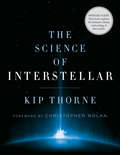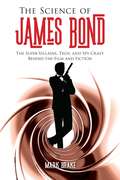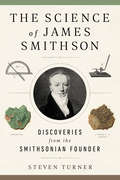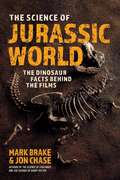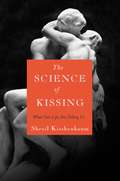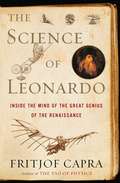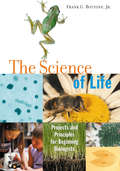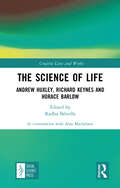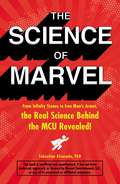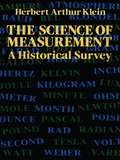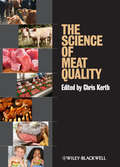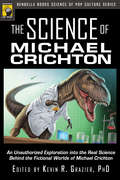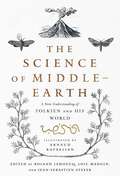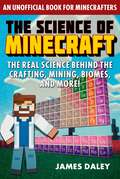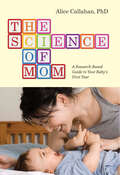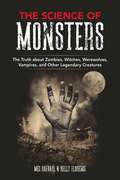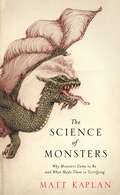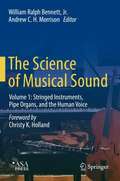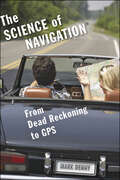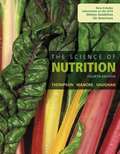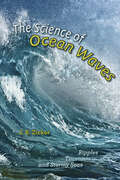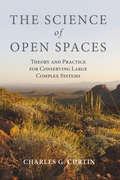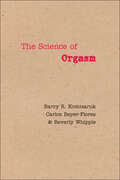- Table View
- List View
The Science of Interstellar
by Kip ThorneA journey through the otherworldly science behind Christopher Nolan's highly anticipated film, Interstellar, from executive producer and theoretical physicist Kip Thorne.
The Science of James Bond: The Super-Villains, Tech, and Spy-Craft Behind the Film and Fiction (The Science of Series)
by Mark BrakeSpy-Fi Culture with a License to KillFrom Sean Connery to Daniel Craig, James Bond is the highest-grossing movie franchise of all time. Out-grossing Star Wars, Harry Potter, and the Marvel Cinematic Universe, the world&’s most iconic and international secret agent has a shelf life of almost six decades, from Dr. No to Spectre. As nuclear missile threats are replaced by a series of subtler threats in a globalized and digital world, Bond is with us still.In The Science of James Bond, we recognize the Bond franchise as a unique genre: spy-fi. A genre of film and fiction that fuses spy fiction with science fiction. We look at Bond&’s obsessions with super-villains, the future, and world domination or destruction. And we take a peek under the hood of trends in science and tech, often in the form of gadgets and spy devices in chapters such as:Goldfinger: Man Has Achieved Miracles in All Fields but Crime!You Only Live Twice: The Race to Conquer SpaceLive and Let Die: Full Throttle: Bond and the CarSkyfall: The Science of CyberterrorismAnd more!This is the only James Bond companion that looks at the film and fiction in such a spy-fi way, taking in weapon wizards, the chemistry of death, threads of nuclear paranoia, and Bond baddies&’ obsession with the master race!
The Science of James Smithson: Discoveries from the Smithsonian Founder
by Steven TurnerAccessible exploration of the noteworthy scientific career of James Smithson, who left his fortune to establish the Smithsonian Institution. James Smithson is best known as the founder of the Smithsonian Institution, but few people know his full and fascinating story. He was a widely respected chemist and mineralogist and a member of the Royal Society, but in 1865, his letters, collection of 10,000 minerals, and more than 200 unpublished papers were lost to a fire in the Smithsonian Castle. His scientific legacy was further written off as insignificant in an 1879 essay published through the Smithsonian fifty years after his death--a claim that author Steven Turner demonstrates is far from the truth.By providing scientific and intellectual context to his work, The Science of James Smithson is a comprehensive tribute to Smithson's contributions to his fields, including chemistry, mineralogy, and more. This detailed narrative illuminates Smithson and his quest for knowledge at a time when chemists still debated thing as basic as the nature of fire, and struggled to maintain their networks amid the ever-changing conditions of the French Revolution and the Napoleonic Wars.
The Science of Jurassic World: The Dinosaur Facts Behind the Films (The Science of)
by Mark Brake Jon ChaseA tale of some of the most amazing creatures ever to grace this tiny planet—unearth how the science fiction of the Jurassic World franchise inspired the evolution of dinosaur science. It all began in 1993. Jurassic Park was a movie landmark in the development of computer-generated imagery and animatronic visual effects. Jurassic Park became the highest-grossing movie of that year, and the highest-grossing film ever at the time, a record held until the 1997 release of Titanic. The field of dinosaur science has blossomed by leaps and bounds and branched out in recent years, in no small part to this iconic movie series. In The Science of Jurassic World, we experience the amazing story of the birth of the dinosaurs, how they evolved to world dominance, how some became gargantuan in size, how others grew wings and flew, and how the rest of them met an untimely end. Chapters include: How did Jurassic Park transform dinosaur science?Was Dr. Alan Grant&’s job a walk in the park?What&’s with the giant dinosaur poop?When will we clone dinosaurs?And so much more! Discover how some of cinema&’s most incredible creations do justice to the jaw-dropping evolution of these fantastic creatures.
The Science of Kissing: What Our Lips Are Telling Us
by Sheril KirshenbaumFrom a noted science journalist comes a wonderfully witty and fascinating exploration of how and why we kiss. When did humans begin to kiss? Why is kissing integral to some cultures and alien to others? Do good kissers make the best lovers? And is that expensive lip-plumping gloss worth it? Sheril Kirshenbaum, a biologist and science journalist, tackles these questions and more in THE SCIENCE OF KISSING. It's everything you always wanted to know about kissing but either haven't asked, couldn't find out, or didn't realize you should understand. The book is informed by the latest studies and theories, but Kirshenbaum's engaging voice gives the information a light touch. Topics range from the kind of kissing men like to do (as distinct from women) to what animals can teach us about the kiss to whether or not the true art of kissing was lost sometime in the Dark Ages. Drawing upon classical history, evolutionary biology, psychology, popular culture, and more, Kirshenbaum's winning book will appeal to romantics and armchair scientists alike.
The Science of Leonardo: Inside the Mind of the Great Genius of the Renaissance
by Fritjof CapraLeonardo da Vinci¿s pioneering scientific work was virtually unknown during his lifetime. Leonardo was in many ways the un-acknowledged ¿father of modern science. ¿ Drawing on an examination of over 6,000 pages of Leonardo¿s surviving Notebooks, Capra explains that Leonardo approached scientific knowledge with the eyes of an artist. Through his studies of living and non-living forms, from architecture and human anatomy to the turbulence of water and the growth patterns of grasses, he pioneered the empirical, systematic approach to the observation of nature -- what is now known as the scientific method. ¿A fresh and important portrait of a colossal figure in the world of science and the arts. ¿ Includes 50 beautiful sepia-toned illustrations.
The Science of Life: Projects and Principles for Beginning Biologists
by Frank G. Bottone Jr.This activity book for budding biologists introduces kids to the five kingdoms of life through 25 engaging projects using materials commonly found around the house, yard, or classroom. Kids will learn how to conduct experiments using the scientific method in a carefully controlled environment. They'll make their own culture media and determine which is more effective at inhibiting the growth of bacteria: an antiseptic, a disinfectant, or plain soap and water. They will delight in collecting and comparing night-flying versus day-flying insects and learn how to clone a mushroom from a piece of its own tissue. Plenty of background information is provided, along with fun facts, a glossary, and wonderful Web sites to explore.
The Science of Life: Andrew Huxley, Richard Keynes and Horace Barlow (Creative Lives and Works)
by Alan MacfarlaneThe Science of Life: Andrew Huxley, Richard Keynes and Horace Barlow is part of the series Creative Lives and Works. It is a collection of interviews conducted by one of England’s leading social anthropologists and historians, Professor Alan Macfarlane. Filmed over a period of 40 years, the three conversations in this volume are part of a larger set of interviews that cut across various disciplines—from the social sciences, the sciences, to the performing and visual arts. The current volume on two of England’s foremost physiologists and a vision scientist is yet another addition to the series of several such books. These Cambridge men of science, Sir Andrew Huxley, Richard Keynes and Horace Barlow, apart from shaping certain very fundamental and critical elements in the disciplines of Physiology and Neuroscience also belong to illustrious lineages. Sir Andrew Huxley, for instance is a direct descendant of T.H. Huxley, while Richard Keynes and Horace Barlow are both the great grandsons of Charles Darwin. Their conversations greatly expand our understanding of physiology and neuroscience. The book will be of very great value not just to those interested in Physiology, Medicine and Neuroscience. The interviews also take us into a fascinating period of Cambridge Science, dominated by certain key families of distinguished thinkers. Print edition not for sale in South Asia (India, Sri Lanka, Nepal, Bangladesh, Pakistan or Bhutan).
The Science of Marvel: From Infinity Stones to Iron Man's Armor, the Real Science Behind the MCU Revealed!
by Sebastian AlvaradoScience meets fantasy in this behind-the-scenes look at the Marvel Cinematic Universe—now you can experience the magic of the movies, and learn how to replicate it in real-life. The Marvel Cinematic Universe is filled with extraordinary humans and abilities. There are teenaged geniuses swinging through the streets of New York, billionaires creating impenetrable armor in hidden caves, and aliens flying through wormholes to Earth. All of these characters seem to lie firmly in the realm of fantasy—but the technology behind them might not be as farfetched as you think… The Science of Marvel pulls back the curtain and reveals the secrets behind Marvel movie magic, and shows us how to recreate these comic book wonders in our everyday life. Using quantum physics, a little bit of mechanical engineering, and some out-of-the-box thinking, you’ll be amazed to discover that it’s possible to create a real-life Captain America, Incredible Hulk, or Black Panther. The perfect gift or collectible for Marvel fans everywhere, The Science of Marvel brings beloved movies and characters to life like never before.
The Science of Measurement: A Historical Survey
by Herbert Arthur Klein"Klein is both a skilled reporter and a wide-ranging humanistic scholar. The book is popular and learned, witty and serious, literary and mathematical -- always solid and entertaining." -- Los Angeles Times.Although the topic of measurement might seem to lend itself to a dry-as-dust treatment, this book is just the opposite: an engrossing, easy-to-read study that treats a multifaceted topic with wit, imagination, and wide-ranging scholarship.Metrology, the science of measurement, usually concerns itself with length, weight, volume, temperature, and time, but in this comprehensive work the topic also encompasses nuclear radiation, thermal power, light, pressure, sound, and many other areas. Representing nearly ten years of research effort, The Science of Measurement is considered a definitive book on the concepts and units by which we measure everything in our universe. Nontechnical in its approach, it is not only completely accessible to the general reader but as entertaining and fun to read as it is informative and comprehensive. " . . . not concerned only with problems of measuring the limits of space or the size of the proton. It is filled with interesting digressions. Not a book for daydreaming, but a book for the curious. Klein's survey of the units and concepts by which we measure everything in the universe helps us understand that universe much better." -- Boston Herald Advertiser
The Science of Meat Quality
by Chris R. KerthMeat has been a long sought after source of nutrients in human diets. Its nutrient-dense composition of protein, fats, vitamins and minerals makes it an integral part to healthy and balanced diets. As demand for meat continues to increase globally, a better understanding of efficiently producing quality meat products is becoming increasingly important. The Science of Meat Quality provides comprehensive coverage of meat quality from the biological basis of muscle development to end-product-use topics such as preparation and sensory analysis.The Science of Meat Quality explores the basis of meat quality long before it hits grocery store shelves. The book opens with a look at cellular muscle tissue development, metabolism and physiology. Subsequent chapters look at topics surrounding the development of tenderness, water-holding capacity, lipid oxidation and color in meat products. The final chapters discuss producing a good-tasting end product from preparing meat to preventing food-borne illness. Each chapter contains not only the theory behind that topic, but also detailed lab methodologies for measuring each meat quality trait. The Science of Meat Quality is an essential resource and reference for animal scientists, meat scientists, food scientists, and food industry personnel. Meat has been a long sought after source of nutrients in human diets. Its nutrient-dense composition of protein, fats, vitamins and minerals makes it an integral part to healthy and balanced diets. As demand for meat continues to increase globally, a better understanding of efficiently producing quality meat products is becoming increasingly important. The Science of Meat Quality provides comprehensive coverage of meat quality from the biological basis of muscle development to end-product-use topics such as preparation and sensory analysis.The Science of Meat Quality explores the basis of meat quality long before it hits grocery store shelves. The book opens with a look at cellular muscle tissue development, metabolism and physiology. Subsequent chapters look at topics surrounding the development of tenderness, water-holding capacity, lipid oxidation and color in meat products. The final chapters discuss producing a good-tasting end product from preparing meat to preventing food-borne illness. Each chapter contains not only the theory behind that topic, but also detailed lab methodologies for measuring each meat quality trait. The Science of Meat Quality is an essential resource and reference for animal scientists, meat scientists, food scientists, and food industry personnel.
The Science of Michael Crichton: An Unauthorized Exploration into the Real Science Behind the Fictional Worlds of Michael Crichton
by Michael CrichtonMichael Crichton’s thrillers traverse the cutting edge of science and then push the envelope. How realistic are his takes on subjects ranging from dinosaur cloning to global warming, nanotechnology to time travel, animal behavior to human genetics? The Science of Michael Crichton gathers essays from prominent experts that examine the amazing inventions of Crichton’s books and lift up the hood, revealing the science underneath—exploring which Crichton imaginings are feasible and which are just plain impossible. Computer science innovator Ray Kurzweil looks at how virtual reality is portrayed in The Terminal Man; anthropologist Ian Tattersall takes on Crichton’s depiction of Neanderthals in Eaters of the Dead; meteorologist David Lawrence discusses global warming in State of Fear—and much more, in a fascinating volume that separates the science from the fiction.
The Science of Middle-earth: A New Understanding of Tolkien and His World
by Arnaud RafaelianThe surprising and illuminating look at how Tolkien's love of science and natural history shaped the creation of his Middle Earth, from its flora and fauna to its landscapes.The world J.R.R. Tolkien created is one of the most beloved in all of literature, and continues to capture hearts and imaginations around the world. From Oxford to ComiCon, the Middle Earth is analyzed and interpreted through a multitude of perspectives. But one essential facet of Tolkien and his Middle Earth has been overlooked: science. This great writer, creator of worlds and unforgettable character, and inventor of language was also a scientific autodidact, with an innate interest and grasp of botany, paleontologist and geologist, with additional passions for archeology and chemistry. Tolkien was an acute observer of flora and fauna and mined the minds of his scientific friends about ocean currents and volcanoes. It is these layers science that give his imaginary universe—and the creatures and characters that inhabit it—such concreteness. Within this gorgeously illustrated edition, a range of scientists—from astrophysicists to physicians, botanists to volcanologists—explore Tolkien&’s novels, poems, and letters to reveal their fascinating scientific roots. A rewarding combination of literary exploration and scientific discovery, The Science of Middle Earth reveals the hidden meaning of the Ring&’s corruption, why Hobbits have big feet, the origins of the Dwarves, the animals which inspired the dragons, and even whether or not an Ent is possible. Enhanced by superb original drawings, this transportive work will delight both Tolkien fans and science lovers and inspire us to view both Middle Earth—and our own world—with fresh eyes.
The Science of Minecraft: The Real Science Behind the Crafting, Mining, Biomes, and More! (The Science of)
by James DaleyDiscover the science behind the Minecraft phenomenon! With more than 200 million units sold, Minecraft is the undisputed bestselling video game of all time. Since it first launched, the game&’s groundbreaking mix of open-world exploration, creative construction, and stunningly simple graphics have kept players old and young alike constantly coming back to explore, survive, and create. Even now, a decade after its release, there are still more than 126 million active users supporting not only the game, but an entire universe of movies, comics, conventions, classes, and so much more. A perfect gift for any Minecraft enthusiast, The Science of Minecraft explores some of the game&’s most popular topics and gameplay mechanics, including: ResourcesMiningConstructionCraftingMechanical DevicesBiomesWeapons and ArmorAnd So Much More This book explains how the game&’s famous construction mechanics would function in real life, what its many natural resources share (or do not share) with their terrestrial counterparts, and what the deal is with the mysterious alternative dimensions of the Nether and the End. Whether you&’re a fan of creative or survival mode, The Science of Minecraft will illuminate and inspire you with the scientific realities behind this iconic game.
The Science of Mom: A Research-Based Guide to Your Baby's First Year
by Alice CallahanThe Science of Mom blogger makes sense of research studies for new mothers.It seems like every time a new mother turns on her computer, radio, or television, she is greeted with news of yet another scientific study about infancy. Ignoring good information isn’t the right course, but just how does one tell the difference between solid studies, preliminary results, and snake oil? In this friendly guide through the science of infancy, Science of Mom blogger and PhD scientist Alice Callahan explains how non-scientist mothers can learn the difference between hype and evidence. Readers of Alice’s blog have come to trust her balanced approach, which explains the science that lies behind headlines. The Science of Mom is a fascinating, eye-opening, and extremely informative exploration of the topics that generate discussion and debate in the media and among parents. From breastfeeding to vaccines to sleep, Alice’s advice will help you make smart choices so that you can relax and enjoy your baby.
The Science of Monsters: The Truth about Zombies, Witches, Werewolves, Vampires, and Other Legendary Creatures
by Meg Hafdahl Kelly FlorenceA must-have for any fan of horror and fantasy movies—Night of the Living Dead, A Nightmare on Elm Street, The Shining (Stephen King), and so many more! If you love film that scares, and want to believe that zombies, vampires, and other deadly and terrifying creatures could be real, let Meg Hafdahl and Kelly Florence, the women behind the Horror Rewind podcast called “the best horror film podcast out there” by Film Daddy, take you to the world where horror and science meet. How would a zombie really decompose in Night of the Living Dead?Are there instances of shape shifting in nature like in The Wolf Man?What is the science behind the night terrors that inspired the creation of Freddy Krueger?Is there scientific data supporting ghost detection like the tools used in Poltergeist?What is the psychological drive that compels cannibals like Hannibal Lecter?How does modern medicine and therapy differ from what would have been offered to Norman Bates in 1960?How are subliminal messages related to propaganda or brainwashing like in The Ring?What would the scientific explanation be for witches possessing people like in Carrie?Was The Blair Witch Project based on any real or imagined creature that came before?”And so much more! Gothic media moguls Meg Hafdahl and Kelly Florence revisit the films from their childhood to discover the science behind the fear. Join Kelly and Meg as they unravel the medical mysteries and scientific marvels that inspired the creation of famous monsters like Nosferatu, Norman Bates, Dracula, Frankenstein, and many more. An approachable and frightfully fun examination of what goes bump in the night, The Science of Monsters will thrill every horror fan.
The Science of Monsters: Why Monsters Came to Be and What Made Them so Terrifying
by Matt KaplanModern audiences do not find dragons frightening. Fascinating as mythical creatures, yes, but terrifying, no. Yet, present them with a story about a virus that can kill a healthy adult in hours and they will have nightmares for weeks. The difference between the two is believability. Monsters are at their most frightening when they carry characteristics that tie them to the real world in some way.Preposterous as they might seem today, dragons were no different in ancient times. Humans long ago stumbled upon skeletons that had sharp teeth and talon-like claws. These fossils were real and some were frighteningly large. Those who looked at them could only guess at how dangerous the animals that they belonged to must have been. From such interactions, dragons were born. Yet, in spite of ample physical evidence that dragons existed, none were ever seen in the flesh. Dragon bones were ultimately proven to be the bones of huge predatory dinosaurs like Tyrannosaurus Rex, but before the mystery was solved, they were the makings of frightening beasts that managed to evade human sight by lurking deep within the shadows of the wild.The Science of Monsters will explore monsters that have haunted humanity throughout the ages, from Medusa to sea serpents, giants, and vampires. In each chapter Kaplan uses scientific principles, current research, and his thorough knowledge of the natural world to explain why specific monsters came to be and what it was about them that was so terrifying to the people who brought them to life.
The Science of Musical Sound: Volume 1: Stringed Instruments, Pipe Organs, and the Human Voice
by William Ralph Bennett Jr. Andrew C. Morrison Christy K. HollandThis textbook is a product of William Bennett’s work in developing and teaching a course on the physics of music at Yale University to a diverse audience of musicians and science students in the same class. The book is a culmination of over a decade of teaching the course and weaves together historical descriptions of the physical phenomena with the author’s clear interpretations of the most important aspects of the science of music and musical instruments. Many of the historical examples are not found in any other textbook available on the market. As the co-inventor of the Helium-Neon laser, Prof. Bennett’s knowledge of physics was world-class. As a professor at one of the most prestigious liberal-arts universities in the world, his appreciation for culture and humanities shines through. The book covers the basics of oscillations, waves and the analysis techniques necessary for understanding how musical instruments work. All types of stringed instruments, pipe organs, and the human voice are covered in this volume. A second volume covers the remaining families of musical instruments as well as selected other topics. Readers without a background in acoustics will enjoy learning the physics of the Science of Musical Sound from a preeminent scientist of the 20th century. Those well versed in acoustics will discover wonderful illustrations and photographs depicting familiar concepts in new and enlightening ways.
The Science of Navigation: From Dead Reckoning to GPS
by Mark DennyIn today’s world of online maps and travel directions delivered wirelessly to hand-held devices, getting from place to place requires little thought from most of us—which is a good thing, since accurate navigation can be tricky. Get your bearings with Mark Denny—an expert at explaining scientific concepts in non-technical language—in this all-encompassing look at the history and science of navigation.Denny’s tour kicks off with key facts about the earth and how its physical properties affect travel. He discusses cartography and early mapmakers, revealing fascinating tidbits such as how changes over time of the direction of true north, as well as of magnetic north, impacted navigation. Denny details the evolution of navigation from the days of coastal piloting to GPS and other modern-day technologies. He explains the scientific breakthroughs in accessible, amusing terms and provides an insightful look at their effects on societies, cultures, and human advancement. Throughout, Denny frames the long history of navigation with amazing tales of such people as Pytheas, an ancient Greek navigator, and Sir Francis Drake and of such discoveries as the magnetic compass and radio direction finding.Whether you have an interest in orienteering and geocaching or want to know more about the critical role navigation has played in human survival and progress since ancient people learned to use lodestones, The Science of Navigation is for you. With it you’ll finally understand the why of wayfinding.
The Science of Nutrition, Fourth Edition
by Janice L. Thompson Melinda M. Manore Linda A. VaughanThe Science of Nutrition is a college textbook.
The Science of Ocean Waves: Ripples, Tsunamis, and Stormy Seas
by J. B. ZirkerAn unparalleled introduction to the amazing world of ocean waves.Outstanding Academic Title, Choice"Powerful ocean waves fascinate the public, and they have made a lot of news lately." With that indisputable observation, scientist J. B. Zirker takes off on a whirlwind tour of the world of waves—from the "ordinary" waves that constantly churn the sea to the rogues or freaks that can rise up seemingly from nowhere to heights of 20 meters or more... and everything in between.Addressing questions most ocean visitors have had and offering new ones for our consideration, The Science of Ocean Waves explains in accessible language how waves are formed, how they move, how they become huge and destructive, and how they're being studied now for clues that will help us plan for the future.Devoting chapters to wind, tides, currents, breakers, tsunamis, forecasting, renewable energy, and El Niño—as well as discussing the gentler properties of ocean waves which inspire us and offer opportunities for relaxation and recreation—Zirker explores the physical factors that create waves.Drawing on some of the recent storms that have devastated entire regions—such as Hurricane Katrina, the tsunami launched by the 2004 Sumatran earthquake, and the great tsunami that crushed the shore of Japan in 2011—Zirker explains the forces that cause these monster waves and reveals the toll they take on human lives.Enhanced by dozens of illustrations and a comprehensive glossary, The Science of Ocean Waves will fascinate anyone curious about the science behind the headlines.Praise for J. B. Zirker"Scientists know their stuff but are rarely good storytellers, whereas good storytellers rarely possess the necessary sweeping command of a scientific discipline. Zirker is that rare animal who can both communicate the most demanding technical detail and make it accessible."—New Scientist
The Science of Open Spaces
by Charles CurtinFrom the days of the American Frontier, the term "open spaces" has evoked a vision of unspoiled landscapes stretching endlessly toward the horizon, of nature operating on its own terms without significant human interference. Ever since, government agencies, academia, and conservation organizations have promoted policies that treat large, complex systems with a one-size-fits-all mentality that fails to account for equally complex social dimensions of humans on the landscape. This is wrong, argues landscape ecologist and researcher Charles Curtin. We need a science-based approach that tells us how to think about our large landscapes and open spaces at temporally and spatially appropriate scales in a way that allows local landowners and other stakeholders a say in their futures. The Science of Open Spaces turns conventional conservation paradigms on their heads, proposing that in thinking about complex natural systems, whether the arid spaces of the southwestern United States or open seas shared by multiple nations, we must go back to "first principles"--those fundamental physical laws of the universe--and build innovative conservation from the ground up based on theory and backed up by practical experience. Curtin walks us through such foundational science concepts as thermodynamics, ecology, sociology, and resilience theory, applying them to real-world examples from years he has spent designing large-scale, place-based collaborative research programs in the United States and around the world. Compelling for not only theorists and students, but also practitioners, agency personnel, and lay readers, this book offers a thoughtful and radical departure from business-as-usual management of Earth's dwindling wide-open spaces.
The Science of Open Spaces: Theory and Practice for Conserving Large, Complex Systems
by Charles G. CurtinFrom the days of the American Frontier, the term "open spaces" has evoked a vision of unspoiled landscapes stretching endlessly toward the horizon, of nature operating on its own terms without significant human interference. Ever since, government agencies, academia, and conservation organizations have promoted policies that treat large, complex systems with a one-size-fits-all mentality that fails to account for equally complex social dimensions of humans on the landscape. This is wrong, argues landscape ecologist and researcher Charles Curtin. We need a science-based approach that tells us how to think about our large landscapes and open spaces at temporally and spatially appropriate scales in a way that allows local landowners and other stakeholders a say in their futures. The Science of Open Spaces turns conventional conservation paradigms on their heads, proposing that in thinking about complex natural systems, whether the arid spaces of the southwestern United States or open seas shared by multiple nations, we must go back to "first principles"--those fundamental physical laws of the universe--and build innovative conservation from the ground up based on theory and backed up by practical experience. Curtin walks us through such foundational science concepts as thermodynamics, ecology, sociology, and resilience theory, applying them to real-world examples from years he has spent designing large-scale, place-based collaborative research programs in the United States and around the world. Compelling for not only theorists and students, but also practitioners, agency personnel, and lay readers, this book offers a thoughtful and radical departure from business-as-usual management of Earth's dwindling wide-open spaces.
The Science of Orgasm
by Barry R. Komisaruk Carlos Beyer-Flores Beverly WhippleWinner, 2007 Bonnie and Vern L. Bullough Book Award, Foundation for the Scientific Study of SexualityThis fascinating and comprehensive book is the first to explore the complex biological process leading to orgasm. Here, sexuality researcher and nurse Beverly Whipple, coauthor of the international best-selling book The G Spot and Other Discoveries about Human Sexuality, joins neuroscientist Barry R. Komisaruk and endocrinologist Carlos Beyer-Flores to view orgasm through the lenses of behavioral neuroscience along with cognitive and physiological sciences. The authors explain how and why orgasms happen, why they fail to happen, and what brain and body events are put into play at the moment of orgasm. No topic is left unexplored, as the book describes the genital-brain connection, how the brain produces orgasms, how aging affects orgasm, and the effects of prescription medication, street drugs, hormones, disorders, and diseases. Covering every type of sexual peak experience in women and menfrom intense to phantom—this informative and entertaining work illuminates the hows, whats, and wherefores of orgasm.
The Science of Orgasm
by Beverly Whipple Barry R. Komisaruk Carlos Beyer-FloresThis award-winning book “offers a thorough compilation of what modern science, from biomechanics to neurochemistry, knows about the secrets of orgasm” (Publishers Weekly).The coauthor of the international best-selling book The G Spot and Other Discoveries about Human Sexuality, Beverly Whipple joins neuroscientist Barry R. Komisaruk and endocrinologist Carlos Beyer-Flores to view orgasm through the lenses of behavioral neuroscience along with cognitive and physiological sciences. Covering every type of sexual peak experience in women and men from intense to phantom, this fascinating and comprehensive work illuminates the hows, whats, and wherefores of orgasm.The authors explain how and why orgasms happen, why they fail to happen, and what brain and body events are put into play at the moment of orgasm. They also describes the genital-brain connection, how the brain produces orgasms, how aging affects orgasm, and the effects of prescription medication, street drugs, hormones, disorders, and diseases.Winner of the 2007 Bonnie and Vern L. Bullough Book Award, given by the Foundation for the Scientific Study of Sexuality
